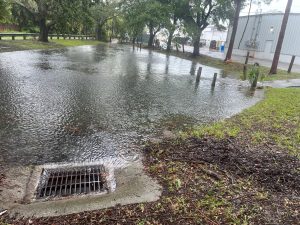Leaves are incredibly fascinating if you spend time taking a closer look, or perhaps feel, or even a smell!
Leaves are made up of multiple layers of plant cells. Plant cells contain chloroplasts. Chloroplasts contain chlorophylls. Chlorophylls are green pigments, and they absorb sunlight. Sunlight and chlorophyll are two key ingredients to make photosynthesis possible. Perhaps you remember this scary formula:
So, chlorophyll captures the light energy from the sun, which enables the carbon dioxide and water to be converted to sugar and oxygen. Still with me?
In the process of chlorophylls absorbing sunlight, they absorb every color of ultraviolet light except green. Since green is not absorbed, it is reflected, making the leaves appear green to us. This time of year, though, you may see leaves of many colors from brown to red and yellow to orange. What happened to the green?
Sunlight (a main driver in photosynthesis) is reduced in the fall/winter when the days get shorter. This reduces the opportunity for photosynthesis to occur. Chlorophyll production slows down and eventually stops. The flow of water and nutrients to and from the leaf is also stopped, trapping remaining sugar in the leaf. When that happens, the other pigments in the leaf (mostly the sugar-loving, red anthocyanins) are on a sugar high and start to show their colors. Once chlorophyll production is stopped and the input and output of the leaf is turned off, there is no need to hold on to the leaf, and thus they fall off. Pretty cool, huh?
If anthocyanins are not prevalent in the leaves, the other pigment, carotenoids will be expressed. You’re probably familiar with carotene in association with carrots and their orange coloration. So, carotenoids are responsible for the yellow, orange, brown colors we see in our sycamore, cypress, oaks and hickories. Carotenoids are always present in the leaf regardless of extra sugar or not, so when photosynthesis stops, if anthocyanins aren’t around, the carotenoids will show up.
Okay, so fun science behind, that’s actually not what I’m here to talk about today. What I really want to discuss is what to do (and not to do) with the leaves once they fall to the ground:
| TO DO | NOT TO DO |
| Rake up the leaves and use them as mulch or bag leaves and dispose according to trash hauler rules | Blow leaves down the storm drain |
Leaves are high in nutrients. This is good for mulching purposes (hence the above “to do”), but bad for water quality (hence the above “not to do”).
What does water quality have to do with leaves? I’m so glad you asked!
In a very urban county like Pinellas, with the exception of some of our much older neighborhoods, most are equipped with two things: 1) storm drains and 2) stormwater ponds.

Storm drains are designed first and foremost to prevent flooding. These storm drains are often connected to a nearby stormwater pond. Stormwater ponds are first and foremost, also designed to prevent flooding. A place for the water to go that
is not your house…yay! Anyone see where I’m going yet?
You have likely seen little placards on storm drains that say something like “Only rain down the drain” or “Drains to bay”. Those aren’t just for fun. Those are for real! It is critical to ensure that only rainwater is going into these storm drains. This is where you can really make a difference.
You can do your part in two ways, or three, if you want to be an overachiever (who doesn’t?).
Option 1) Participate in the County’s Storm Drain Marking Program. If you see a drain that is not marked with a storm drain placard, email the Coordinator.
Option 2) Participate in the County’s Adopt-A-Drain Program. If you see a drain that is constantly clogged, covered or overwhelmed with leaf fall, trash, or debris, you can adopt one or more drains to maintain for a year.
Option 3) The overachiever option…all of the above.
Research shows that leaf fall is a significant contributor to excess nutrients in stormwater ponds. This can lead to problems like algae blooms and fish kills. Leaf fall is natural, but it’s not designed to be carried away during a rain event and funneled into a stormwater pond. Natural leaf fall in a natural system is a beautiful thing! Help us raise awareness about keeping our storm drains free and clear of litter and debris and ensuring they are marked with a placard.
Want to learn more? Check out my:
- Water blogs
- Guest blog from a Florida Waters Stewardship Program graduate
- Naturally Florida podcast
- On-demand videos
Happy Learning,
 2
2







